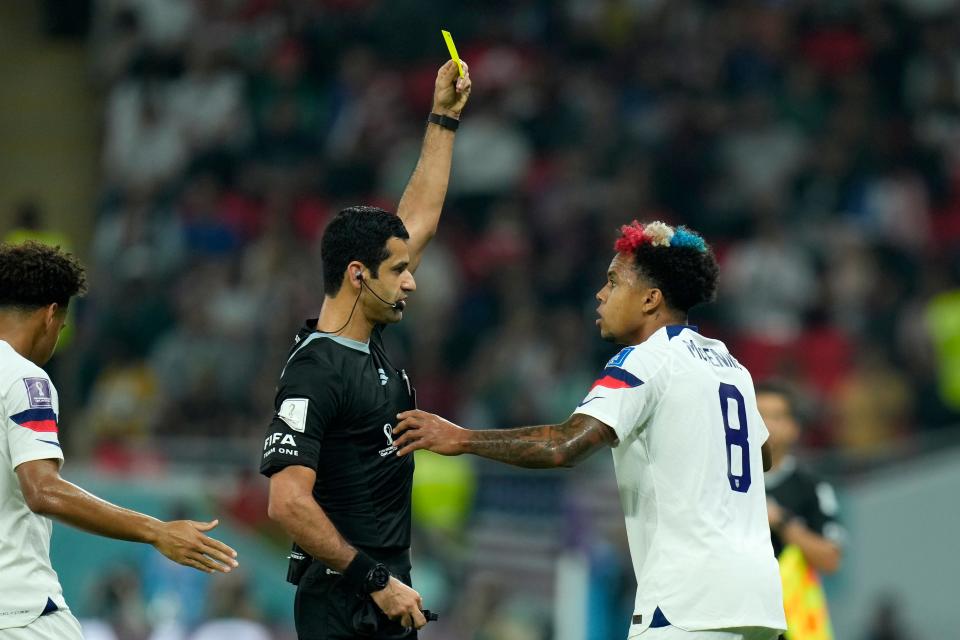What are soccer's yellow card rules? How players get red cards, suspensions in World Cup
As the U.S. men's national soccer team prepares for its World Cup Round of 16 showdown against the Netherlands on Saturday (10 a.m. ET on FOX), there are a handful of players carrying yellow cards who could risk a one-game suspension if they are penalized as such again.
In Tuesday's win over Iran that sent the USMNT into the knockout rounds, team captain Tyler Adams was issued a yellow card. In the team's tournament-opening 1-1 draw with Wales, Kellyn Acosta, Sergiño Dest, Tim Ream and Weston McKennie each were issued yellow cards.
All five players run the risk of missing the quarterfinals (should the U.S. advance) if they are issued another yellow card on Saturday.
WORLD CUP 2022: Schedule, scores and latest news
OPINION: USMNT sees reaching World Cup knockout rounds as means to end, not signature achievement
FUTBOL, FOOTBALL AND EVERYTHING IN BETWEEN: Sign up now to get top sports headlines delivered daily

What warrants a yellow card in soccer?
Explaining what exactly a yellow card in soccer means is like trying to explain umpire Ángel Hernández's strike zone to baseball fans.
Basically, it's a foul, and the degree of which will dictate whether it's a warning to the player or if said player receives a yellow card. Oftentimes, that all depends on the referee.
Generally speaking, a referee will present a yellow card in order to caution a player for unsporting behavior, repeated infringement of the rules of the game, dissent by word or deed, not maintaining correct distance from a corner or free kick, leaving or re-entering the field of play without the referee's permission, or delaying the restart of the game. All of these infractions, of course, are up for interpretation by the referee.
What does a yellow card in soccer mean?
Think of it as a personal foul penalty in football ... except worse.
A yellow card can have implications that go well beyond the current game being played.
In terms of the current game being played, once a player receives a yellow card, it's imperative to avoid a second yellow card. If a second yellow card is presented by the referee, then that referee also will present a red card. That means a player is ejected from the game. This is bad for a number of reasons. One, an ejected soccer player – unlike in baseball, basketball or football – cannot be replaced by another player; that player's team must play at a personnel disadvantage. Two, the player who received the red card cannot play in their respective team's next game.
Yellow and red card accumulation also can factor into which teams advance to the knockout stages.
Behind most points, goal differential and total goals scored in group play is the "highest team conduct score relating to the number of yellow and red cards obtained" tiebreaker.
Per FIFA's "fair play rule," each team is deducted points on their conduct score as such: yellow card: minus 1 point; indirect red card (as a result of two yellow cards): minus 3 points; direct red card: minus 4 points; yellow card and direct red card: minus 5 points.
The "fair play" tiebreaker nearly came into play on Wednesday on the final day of Group C play. For a moment, Mexico and Poland both had four points, a goal difference of zero, two goals for, and two goals against. Poland owned the "fair play" tiebreaker. A late Saudi Arabia goal assured that the "fair play" tiebreaker would not be used to decide the second-place finisher, behind Argentina, of Group C. Poland moved on to the Round of 16 and Mexico failed to advance to the knockout rounds.
How many yellow cards can you get at the World Cup?
Per FIFA: "If a player receives two cautions in two different matches, he will be automatically suspended from his team’s subsequent match."
Also per FIFA, "Single yellow cards in the final competition will be cancelled after the quarter-finals."
A second yellow card during the Round of 16 matches could result in being ineligible to play in the quarterfinals. However, all accumulated yellow cards for every player for each semifinal team will be wiped after the quarterfinals. This means semifinal participants will not be at risk of missing the World Cup final over yellow card accumulation. Unless, of course, a player receives two yellow cards, or a red card, in the semifinal, resulting in a player suspension for the final (or the third-place game).
Any suspension that can't be served during the World Cup will carry over to that player's next official national team match.
This article originally appeared on USA TODAY: World Cup 2022 yellow card accumulation rules: How USMNT is impacted

